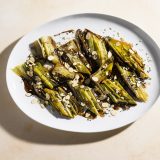Wine barrels darkened with age line the tiled walls of Casa Montaña, a restaurant virtually unchanged since it opened in 1836, when this part of Valencia was still filled with fishermen. And perhaps as a testament to the timelessness of Spanish cooking, little on the menu has changed since then, either.
“The past to us is like an inheritance,” chef Roberto Lozano says as a midday scene unfolds before us in typically Spanish fashion. Friends, unhurried and communal, gather well into the afternoon for the big meal of the day, each tapa shared, each fresh glass of wine clinked with a “Salud!” to good health.
The tables fill with quality ingredients simply prepared, most of them only sliced and plated or seared on a flat-top grill and served with little more than a sprinkle of sea salt and a drizzle of olive oil. Grilled fresh artichokes, glistening head-on sardines, paper-thin slices of serrano ham, chunks of beef seared with garlic oil.
Other dishes—slightly more involved, though not by much—draw me in as I slowly work my way through the voluminous menu. Stuffed piquillo peppers, baby broad beans stewed with Iberian ham, a slice of toasted baguette with goat cheese, honey and diced red peppers.
The real surprise, though, are the leek hearts poached in olive oil and drizzled with a tangy-sweet balsamic glaze. Like many, I considered leeks a background player unworthy of attention on their own. But these leeks had me rethinking that.
Once the fibrous outer layers are removed, the hearts are poached in olive oil and water at a low temperature, a process that renders them silky and tender. The vegetable retains its mild spring onion flavor with none of the raw allium pungency. It’s a wonderful example of letting the natural flavor of an ingredient shine through.
Because the leeks available in the U.S. tend to be larger and tougher than those in Spain, we found we couldn’t simply peel away a couple layers and cook. Instead, we halved 2-inch pieces lengthwise and cooked them cut side down.
This provided two advantages. First, the flat side had more contact with the pan than an uncut round leek, which promoted browning that added flavor. Second, the smaller pieces took less time to cook through. We also found that cooking the leeks with butter as well as olive oil helped create an unctuous sauce. We started the leeks with the oil and butter in a cold pan, rather than adding them to hot fat, to gently coax out more of the leeks’ sweetness.
Lozano’s update to this age-old preparation was a zigzag of balsamic glaze. We loved that, then added a few other tweaks. Toasted almonds added textural contrast, and we liked the stronger flavor of honey in the glaze. Still simple. Simply delicious.
“If you have a good product, you don’t have to cover it with a lot of sauces,” says Lozano. “We try to touch it as little as possible.”
Meltingly Tender Leeks with Balsamic Glaze
Leeks turn jammy-soft when braised with olive oil, butter and fresh thyme.
Photo: Connie Miller of CB Creatives; Styling: Christine Tobin







